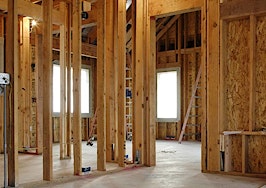Takeaways:
- New home permit activity in the U.S. remains 60.7 percent below 2005 levels.
- In contrast, activity in the remodeling industry (by permits pulled) has fully recovered from the housing bust and is 3.4 percent above its 2005 level.
- Four of the nation’s five largest metros have seen noticeable year-over-year improvement in new home construction; however, these levels still significantly trail activity seen in 2005.
The remodeling industry has fully recovered and surpassed its precrisis index levels, while new home construction activity is recovering at a slower rate.
According to a new set of residential construction and remodeling indices launched by BuildZoom, new home permit activity remains 60.7 percent below 2005 levels. When comparing first-quarter 2015 to first-quarter 2014, new home construction declined by 0.3 percent.
In contrast, activity in the remodeling industry (by permits pulled) has fully recovered from the housing bust and is 3.4 percent above its 2005 level. Year over year, the sector has seen a positive change of 7.3 percent.

Estimated at roughly $300 billion a year, the residential remodeling market is roughly comparable in size to the 2014 $340 billion value of residential construction, according to BuildZoom.
“Despite its size, and even though it is a good indicator of consumer confidence, residential remodeling is generally overlooked,” said Issi Romem, chief economist at BuildZoom. “Remodeling provides a more evenly distributed view of the economy that is more likely to represent conditions in the nation as a whole.”
The existing focus on new construction imposes a view of the economy that overemphasizes conditions in high-growth metro areas, and in particular on their fringe, where new home construction is concentrated, Romem added.
The indices also broke down new home construction and remodeling activity in five of the nation’s largest metros. Four of the five metros have seen noticeable year-over-year improvement in new home construction; however, these levels still significantly trail activity seen in 2005.
Of the five metros, new home construction activity improved most in the San Francisco Bay Area — increasing 64.9 percent year over year. Despite this large rise, building activity trails 2005 by 64 percent. Remodeling activity was also up year over year, by 9.1 percent, but trailed the level from 10 years ago by 16 percent.
In Chicago, permits for new homes rose 2.4 percent year over year but trail 2005 levels by 52.4 percent. Remodeling activity in the metro was up 21.6 percent year over year but down 8.6 percent when compared to 10 years ago.
Dallas-Fort Worth also saw noticeable year-over-year improvement in new home permit activity, rising 28.2 percent. Home construction levels still trail 2005 by 52.3 percent. Remodeling was up in the metro by 3.1 percent year over year but down 34.1 percent compared to 10 years ago.
Both new home construction and remodeling activity were up year over year in the Phoenix metro. The market saw a 19.2 percent rise in new construction and a 3.2 percent bump in remodeling volume. However, these activity levels trail performance in 2005 by 69 percent and 12.1 percent, respectively.
The San Jose metro is the one outlier among the metros analyzed. New home construction in the market dropped year over year by 25.5 percent and trails 2005 levels by 24.3 percent.
Remodeling activity in San Jose was, surprisingly, down year over year, dropping 2.4 percent.








